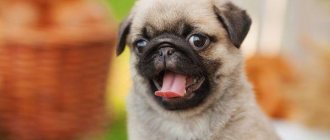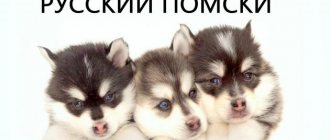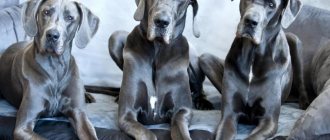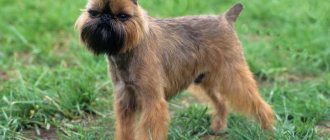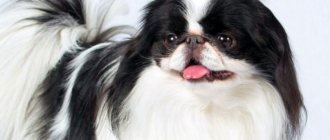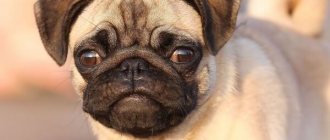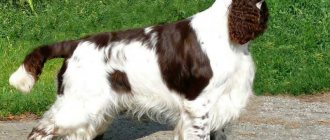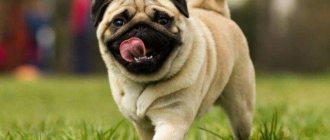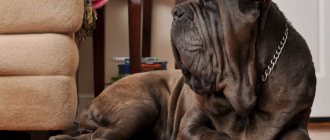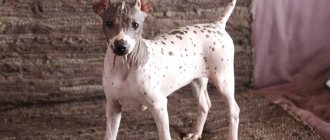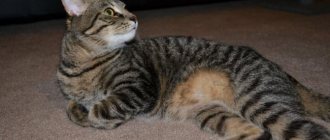History of the origin of the breed
Pugs are incredibly charming dogs with a cheerful disposition.
The pug breed comes from Ancient China. Dogs that are very similar to modern pugs were first mentioned in the 2nd century BC. e. In the 16th century, the breed began to conquer Europe, starting from Holland, where it arrived on merchant ships and from where it quickly spread to other countries.
In 1882, the English Pug Club was founded, where painstaking selection work was carried out and the best qualities of the breed were cultivated. In the 19th century, the fashion for cute animals began to gradually fade away. In the 20th century, a boom in pugs began again; they were especially popular at exhibitions.
Additional Information! In China, the breed was highly valued and was treated with great honor and respect. The first images of pugs, slightly different from modern representatives of the breed, are found in the “Imperial Book of Dogs”.
History of the breed
The history of pugs is associated with myths and legends. The first images of the breed's progenitors date back to the period of the birth of Buddhist culture in the East. China is considered the birthplace of pugs.
Small dogs with a square, short muzzle are mentioned in early Indian manuscripts. It is known that in China at the same time there were dogs Ha Pa and Lo Jie, the former were long-haired, the line of Pekingese supposedly began with them, the latter were smooth-haired, closer to pugs. The ancestors of the Pekingese could only live in the imperial palace and were revered as sacred dogs. And pug-like dogs inhabited the homes of the nobility and the rich.
When trade relations were established between the Far East and Europe, the exchange of animals became possible. Pugs were exported to other countries, where they became everyone's favorites. In the 16th century, pugs became a mature breed, popular with noble ladies. They attracted attention in high society and became models for painters and sculptors. Dogs have become especially popular in England - the country even took charge of the breed and gave it the name Pug. Serious work has been carried out in the country to breed and develop the breed characteristics of pugs. A club for breed lovers was created in 1883, and in 1885 an introduction was held with the participation of stocky dogs. The breed standard was adopted 3 years later.
Today, pugs are respected in many countries as wonderful companions and family pets.
Breed Features
The pug dog breed is always positive and incredibly charming. This pet is full of advantages, but also not without disadvantages. You need to learn about all the features in advance in order to understand whether you can raise your pet properly.
Pugs are unpretentious in their maintenance, but like other decorative breeds they require due attention.
Advantages and disadvantages
Advantages of the Chinese breed:
- friendly and affectionate disposition;
- complete dedication to the owner and devotion, in this characteristic the pug can be compared with a shepherd;
- ideal friend for young children;
- flexible, sharp mind and thirst for learning;
- friendly attitude towards other animals;
- easy pet maintenance;
- the ability to live in small apartments;
- no need for frequent and intense physical activity.
If you want to know more about pugs, you cannot ignore the disadvantages of the breed:
- sometimes shows strong stubbornness;
- reacts poorly to high ambient temperatures;
- has a predisposition to obesity;
- molting continues throughout the year;
- wool emits a rather specific, unpleasant odor.
Additional Information! Pugs are known for the fact that they hardly bark, but they snore very loudly.
Description of the pug breed and the FCI standard
There is a certain standard for the pug breed (FCI FROM 06/24/87). According to it, the general appearance of the dog must comply with the following rules. A representative of the breed is a distinctly square, stocky dog. It concentrates the proportionality of shapes, compact format and highly developed muscles. The body should be short and powerful, wide in the chest, with well-defined ribs. The topline is straight.
The pug dog breed, a photo of which is in this article, has three types. This is a terrier or lightweight type, bulldog and sharpei. The first type is distinguished by a slightly elongated neck and straight torso. It is this type of dog that is attractive and in great demand.
The second type is the bulldog. They have a wide torso and slanted shoulder blades. The Shar Pei type has many folds. If you look at such a dog, it may even seem that it is overfed. Such dogs are not allowed to compete.
Pugs are stocky and muscular dogs, despite their small size. They have a square format. Males of the breed reach a length of 30-35 cm and a weight of 6-10 kg. Females are somewhat smaller: 25-30 cm, weight - 6-8 kg.
The head of pugs is round and large, the muzzle is short and not upturned. It has wrinkles and folds. The eyes are dark, round, shiny, full of fire, intelligent and meaningful, they are very well expressed. Their view is compared with the view of a philosopher who has learned the wisdom of existence. At the same time, in a playful mood, the expression in the eyes becomes cheerful.
The ears are small and fit tightly to the skull. If you touch them, they feel like soft and pleasant velvet. According to the first standards, pug ears were cropped, but at the end of the 19th century it was decided to abandon cropping. According to the standard, pug ears can be either buttons (covering the shell) or rosettes (the shell is slightly open).
The lower jaw is quite wide; normally, the bite of pugs is a slight undershot, the teeth do not stand out. Misaligned jaws and protruding tongue are not considered normal! Although in England, the protruding tongue was previously considered a preferred external feature of pugs.
The neck is relatively powerful, strong, thick, and long enough to carry the head proudly. The chest is wide, the back is straight.
- Country of origin: China.
- FCI classification: group 9. Toy and companion dogs. Section 11. Small molossoids. No operational tests.
- Format: square, proportional.
- Head: round, large, not “apple-shaped” (this shape is considered a defect). When viewed from the front, the skull is flat between the ears. The forehead does not protrude above the brow ridges.
- Muzzle: short, square, flattened, almost equal to the width of the forehead.
- Wrinkles: clearly visible, ideally forming a beautiful, symmetrical pattern. Jowls should not droop.
- Fold above the nose: continuous or intermittent. Too thick or thin disrupts the harmonious structure of the head.
- The bridge of the nose: straight, slightly pronounced, complete absence leads to breathing problems, heart failure, fainting during severe anxiety or physical exertion. Strongly concave (snub-nosed) is characteristic of the Japanese Chin, Brussels Griffon, and French Bulldog.
- Nasal passages: shortened, but not curved.
- Nose: black with well developed nostrils.
- Lower jaw: wide, chin well defined.
- Eyes: large, dark in color, round, protruding, set wide apart in line with the nose. Slanting, almond-shaped or bulging are considered a fault.
- Overbite: tight overbite no more than 3 mm. The incisors of the lower jaw are positioned evenly - in a “ruler” and tightly overlap the upper incisors.
- Ears: thin, small, soft, set high, close to the head.
Divided into two types:
- “Rose” - small, folded over the head, laid back, the inside is open.
- “Buttons” - laid forward, the edges are pressed tightly to the head, covering the internal holes.
- Neck: slightly curved, strong, thick, of sufficient length, with a well-defined scruff, the transition of the neck to the withers is smooth, the posture is proud.
- Body: short, stocky with well-developed muscles. The length of the pug's body is almost equal to the height at the withers.
- Chest: Broad, with well sprung ribs. The lower part of the chest is located no higher than the level of the elbows. The underline is slightly drawn towards the hind legs. Too wide, or “chicken breasts,” is considered a defect.
- Forelegs: smooth, strong, straight, well-developed muscles on the outside of the legs, forming a smooth arch. They are located far from each other, the shoulders are sloping. The elbows fit tightly to the body and are directed strictly back. The pasterns are slightly inclined. The inclination of the scapula is 45 degrees, forming a right angle with the humerus. The length of the shoulder blade and shoulder are equal. When viewed from the front from the side, the sternum has a good protrusion.
- Hindquarters: strong, parallel, thighs muscular, knee and hock joints clearly defined.
- Croup: full, slightly rounded.
- Tail: thick, set high, curled, pressed close to the body, densely covered with hair. A double ring is considered a virtue.
- Coat: short, smooth, close-lying. The guard hair is thin, smooth, shiny. The undercoat is soft and dense. Black pugs have coarser fur than light pugs and have blue skin. Some individuals have no undercoat.
- Skin: elastic, covers prominent muscles, not saggy, but not tense.
- Movement: springy, free, elegant.
The photo shows a black pug puppy
Weight: ideally - 6 - 8 kg.
Height at withers: 28 – 32 cm.
Color: black, silver, beige, apricot. With clear contrast between markings and color. Possible o on the forehead, ears, mask, moles on the cheeks, claws and a “belt” on the back.
Coat: not hard, not fluffy, not long, shiny.
Appearance
Varieties
This dog breed is compact and solid. And the most important thing for a breeder is to preserve the breed type.
There are three types of pugs:
- Terrier type (light). Characterized by a long neck and an elongated straight torso. Currently considered the most attractive.
- Bulldog variety. The difference is that the torso is too wide and the shoulder blades are set obliquely. Possible tied shoulder blades and barrel-shaped forelimbs.
- Shar Pei type (most unacceptable). An overly fattened dog with a lot of folds. This is done in order to hide an irregular or elongated topline. Unfortunately, in the 90s, Shar-Pei pugs even received awards at exhibitions.
We suggest you familiarize yourself with: Breed standard weight and size of dachshund
The pug is a balanced dog. He should be stocky, not fat or thin, and have strong, well-developed muscles, and not be obese.
Beige color
Description of the pug according to the standard
The breed standard was drawn up in 1987.
Head
The dog's head is massive, large, without pronounced dents or other irregularities. The muzzle is square-shaped, blunt, and has symmetrically located wrinkles.
Additional Information! The pug is brachycephalic. The term refers to breeds with a short head and a flat muzzle.
Jaws
Dogs have a pronounced protruding lower jaw with an expressive chin. The snack is dense. The lower incisors are straight and overlap the teeth of the upper jaw.
Nose
The bridge of the nose is small, straight, but well defined. The nasal passages are shortened. The lobe is on the same line in relation to the eyes, it is located exactly in the center.
Eyes
Characteristics of a pug breed should begin with its eyes. They are large, round, moderately convex, but without protrusion. The fit is wide. The color is dark, without expressive whites.
Despite the cheerful and good-natured nature, there is always a bit of sadness in the pug’s gaze
Ears
Compared to the head, the ears are small, soft and thin to the touch. For a dog called a pug, the breed description according to the standard allows for two ear shapes:
- ears laid forward, the edges pressed tightly against the skull, closing the holes inside the shell;
- the ears are laid back and folded over the skull, the holes inside are open.
For pugs, it is preferable to have the first ear shape.
Neck
The length of the neck in relation to the body is absolutely proportional. It is powerful, comb-shaped, strong.
Frame
The body is massive, strongly built, but short. The chest is wide, the ribs are laid back and pronounced. The top line of the back is straight.
Limbs
Although pugs are small, their paws are well developed:
- The forelimbs are located under the body, their length is average, the muscles are developed.
- The hind legs are strong, straight, they are located strictly parallel to each other. The length is average. The knee joints are pronounced.
The toes have a clear demarcation.
Tail
Even those who are not dog lovers know what a pug looks like. Besides its prominent jaw and eyes full of love and interest in the world around it, the dog's special feature is its tail. It is straight, short and wide. Covered with dense wool. It has a high waist and is pressed close to the body.
The tail is curled into a ring, and those representatives of the breed with a double curl of the tail are most valued.
Wool
The animal's hair is close to the body, it is short and thin. The wool is soft and smooth to the touch. The length is the same almost all over the body, but on the head it is slightly shorter.
Additional Information! The peculiarity of the pug breed is that dark-colored dogs have coarser fur than their light-colored counterparts.
Color
When learning everything about the pug breed, you need to familiarize yourself with what types of coat colors are allowed according to the standard:
- black;
- apricot;
- beige;
- silver.
Dogs of beige, silver and apricot color must have a pronounced contrast between the main color of the coat and dark spots in the form of a mask on the head and ears.
The standard allows for the presence of a “strap” - a dark-colored strip that runs along the spine from the back of the head to the tail. The so-called “diamond” is allowed - a dark-colored spot on the forehead.
Description of the breed
The Pug is a breed of dog whose representatives have dense and short hair. But it is soft and shiny. The color of such a dog may be different. Thus, there are dogs of fawn, apricot, silver and other colors. It is known that until the 19th century, black dogs were destroyed. Now they are widespread and popular.
The head of such dogs is large and round in shape. Between the ears, the part of the skull is flat, and the forehead does not protrude above the brow ridges. The animal's muzzle is flattened and equal in width to its forehead. But on such a charming face, wrinkles are clearly visible, which form a symmetrical pattern. The pug has a fold under his nose that is very thin and does not fit well with his large head. This strip can be intermittent, or it can be continuous. For the pug breed standard, snub nose is not the best characteristic.
Many people buy such a dog as soon as they see its eyes. Shiny and huge, lively and round, they amaze with their dark color. They are set deep on the muzzle in line with the nose and have a slight slant.
The ears of dogs that are so popular are thin and soft. It is known that the pug breed standard defines ears as velvety to the touch. Set high, they lie close to the dog's head. By their shape, you can determine the type: “button” or “rose”. The first type consists of ears laid slightly forward, the inside of which is slightly covered. This type is considered the most common. The second type involves hearing organs laid back with an open interior.
A pug's teeth are quite strong. Usually one always pays attention to his lower jaw, which protrudes forward. The bite of such a dog is approximately three millimeters. The lower incisors overlap the upper ones. But at the same time, the teeth remain closed, and the tongue is never protruded. The pug's neck is not so attractive, since it is thick and short, but it is very strong and strong.
Dogs like the pug are often called square dogs. They received this definition for their muscular and dense body, which is also well developed. The pug's forelimbs are also well developed. They are located far from each other and give the animal a serious appearance. The hind limbs of such a dog are powerful and strong, they have an excellent hock joint.
The pug's strong and well-developed paws are usually of medium length. Their toes are always clearly separated, and their claws are black. The entire appearance of the pet is complemented by a thick tail, which is set high on the body. It is always wrapped in a tight ring and pressed tightly to the body. If the tail ring is double, then this is considered a serious advantage of the representative of the breed.
The pug's movements are very elegant, which is also determined by the breed standard. A black pug is not a rare occurrence, but it is the one that evokes the most positive emotions. It's always a pleasure to look at such a four-legged friend. The gait of all representatives of this species is free, light and even slightly springy.
Disqualifying faults
If the owner of a pug is planning for his pet to participate in exhibitions, it is important to know that there may be some features in their appearance that are disqualifying defects, and a purebred dog should not have them:
- apple-shaped skull;
- strongly prominent frontal bone, similar to that of the Japanese Chin;
- the bridge of the nose is poorly visible or absent;
- the nasal fold is asymmetrical;
- light-colored lobe;
- eyes - too protruding, light, small, slanted or almond-shaped;
- a distorted oral cavity, due to which the tongue protrudes or the teeth are severely exposed;
- arched chest shape;
- the neck is too short or, conversely, excessively long.
A culling breed is considered to be a long-haired or hairy, shaggy pug with a fluffy coat.
An atypical coat color is considered a cull.
Pug character and behavior
In describing the character of the pug breed, all owners agree that it is difficult to find a more affectionate and flexible dog. Features of character and behavior:
- Pug puppies are incredibly active and playful, but as they age, their activity decreases significantly.
- Dogs are very attached to household members, which is why they cannot be left alone for a long time. Pugs tolerate loneliness extremely poorly and experience severe stress.
- The character of pugs, unlike most decorative breeds, is balanced and calm. If the pet wants the owner to pay attention to him, he will come up to him and just sit next to him, but he will never brazenly climb into his arms.
- Dogs will never bark for nothing. It is not often that you hear a pug bark. But they make grunting and wheezing sounds, and they do it especially loudly.
Additional Information! What is a pug - it is not just a pet, but a full-fledged member of the family, children especially love it, and these feelings are mutual.
Children need to be taught the rules of behavior with a dog so that during active games they do not cause injury to the animal, especially to the eyes.
Pug breed standard eriksoniana 02/01/12, 21:20
Pug breed standardGeneral form
The Pug is square and stocky, so to speak “a lot in a little” - expressed in a compact shape, good proportions and well-developed muscles.
Character
Very charming, noble and intelligent.
Temperament
Balanced, cheerful, lively and cheerful.
Head
Large, round, but not “apple-shaped”, without indentations on the skull. The muzzle is short, blunt, square, not upturned. Wrinkles are clearly visible.
Eyes
Dark, very large, round in shape, with a gentle, meek and full of desires expression, very shiny and full of fire when excited.
Ears
Thin, small, soft, like “black velvet”. Two varieties are "roses" - small ears folded over the head, pulled back so that the inside is exposed. “Buttons” - ears laid forward, the edges pressed tightly to the skull, covering the internal openings. The latter are preferred.
Mouth
Small snack. A lopsided (crooked) mouth, protruding teeth and protruding tongue are highly undesirable. The front teeth (incisors) of the wide lower jaw are always in a straight line.
Neck
Slightly curved, comb-like, strong, thick, of sufficient length to carry the head proudly.
Forelegs
The legs are very strong, straight, of moderate length, mutually parallel. Sufficiently placed under the body (they are “well under the dog”). Shoulders are well sloping.
Torso
Short, stocky with a broad chest and well sprung ribs. The topline is straight, never arched (concave) or sloping (sloping).
Hind limbs
The legs are very strong, of moderate length, well angulated, straight and mutually parallel when viewed from behind.
Paws
Not as long as a hare's, and not as round as a cat's. Toes well separated, claws black.
Tail
Set high, curled as tightly as possible, pressed to the back. A double curl is more desirable.
Movements. When viewed from the front, the forelegs rise and fall directly under the shoulder. The paws are directed straight, turning neither in nor out. When viewed from behind, the picture is similar. The forelimbs move with a good, strong swing. The hind limbs move freely, with good mobility in the knee joints. The gait is characterized by slight rolling movements of the rear part.
Wool
Fine, smooth, tender, short and shiny (never hard or fluffy).
Color
Silver, apricot, fawn and black. Each of these colors must be clearly expressed so that there is a clear contrast between the main color and the mask. Markings should be clearly visible: the muzzle or mask, ears, warts on the cheekbones, a diamond or fingerprint-shaped spot on the forehead and a dark line on the ridge should be as black as possible.
Size
Ideal weight 6.3-8.1 kg.
Flaws
Any deviations from the above-mentioned points shall be regarded as defects, and the seriousness with which they shall be taken into account shall be strictly in accordance with the degree of deviation.
Note
Males must have two normally developed testes, fully descended into the scrotum.
::Comments to the standard::
The original comments of the standard are given from the book “MOPS”, authors Zakharov, Milyukova, 2004 edition.
It is fair to say that any dog that has all the characteristics described in the Standard should be a very good Pug indeed, with few minor faults. There should be nothing that would cause confusion or uncertainty to anyone reading the Standard. A small dog, the body structure is square, stocky, with heavy powerful bones, a large head in proportion to the size of the dog, with short smooth hair and a tail in the form of a dense curl. The description of the pug suggested by the Standard is an excellent representation of the type, but does not reveal the true picture of the dog's articles, so it would not hurt to expand and emphasize some of its requirements.
::General form. Symmetry::
In the assessment, the dog as a whole is considered first: is this pug a reflection of the breed type? Do all the parts fit together harmoniously? The Pug is a well-balanced dog. The expression “Multum in porvo” - “big in small” - is realized thanks to stockiness, strong bones and well-developed muscles. For its small size, the pug should look very solid and compact, with a lot of muscle mass and strong musculature, and in no way obese. You must remember that the pug is a dwarf dog, not too big and not too small, and is similar in design to a small, stocky squat horse / cobby / Reading the “General Appearance” clause in the Standard you will not find an expressive description of one thing - it is not given any attention sufficient attention is the “hardness of developed muscles.” This characteristic is very important and one cannot ignore it, since the correct movements of the dog can be distorted if the dog is not in good condition. Fat and thin dogs are equally undesirable. There is an opinion that you don’t have to walk or walk with a pug, but there is very little that a pug cannot withstand long walks - all this is not true. A good muscular frame is achieved not by feeding, and certainly not by diet, but by regular training (walking). Walking along the road at a measured and controlled pace is just as necessary as free jogging. Walking on heavy surfaces (sand, gravel, tall grass, water, deep snow) is good for both body and leg muscles, but should not exceed 30 minutes (10 minutes is enough in hot or very cold weather) if the time is quiet the walk is 1-1.5 hours. American expert and breeder with more than 50 years of experience, Thomas Shirley, in his book “The neu mops,” talks about the problems that American breeders face in maintaining the breed type: “For many years, breeders have tried hard to produce quality pugs. We have come a long way, and yet we still have to overcome many obstacles. The main thing is to preserve the breed type. Do you know the difference between the three types of Pug - Terrier, Bulldog and Chinese Shar-Pei? The elegant (lightweight) terrier type of pug stands out among all the others. He has a conspicuously long neck, which turns into a straight front (perpendicularly set shoulder blades and forelimbs). I am perplexed to hear that most people prefer this particular type, considering it more attractive. It's a shame that today such dogs too often become winners. The bulldog type is characterized by an extra-wide front and an attractive head supported on obliquely set shoulder blades. Sometimes you will see in dogs of this type a barrel-shaped set of the forelimbs or connected shoulder blades. The most unacceptable is the modern type of Shar Pei and we must not allow it to spread. Due to the desire of one or two hobbyists and a number of breeders for great fame, we saw these heavy pugs with swaying croup. This is not typical for a pug. They try to fatten up dogs to hide their long back or irregular topline. Since pugs came from China to Holland and England, and then to America, they only had rolling shoulders, but not rumps. We must stop those who try to convince our experts, new breeders and inexperienced owners that a Pug's croup should swing when moving. If they are not stopped in time, they will destroy the correct breed type. In the mid-90s, the dominance of just such large, raw, frankly short-legged, pig-like sharpei-type pugs began in Russia. The fatter and rawer the dog was, the higher place it occupied. It was painful to hear that with the advent of dogs of this type, the breed began to improve dramatically+ But time put everything in its place.
::Character .Temperament::
A lot of charm, dignity and intelligence, courage and innate contact. They are easy-going, loyal, mischievous and strive to be the center of attention. At times quite jealous and suspicious. Pugs in a pack are fearless. They are all good watchmen. They love to play with children. There are differences in the temperament of black and light individuals: light ones tend to be calmer and more devoted, while black ones are wary and energetic. Shyness, nervousness, aggression are serious shortcomings.
::Head::
The pug's head should be conspicuous. It should be large, round, but not an “apple”, without clearly defined skull bones. The top of the skull, visible from the front, should be almost flat between the ears; The eyes are set quite wide, in line with the nose. The muzzle should be broad but balanced with the correct depth (flatness). The lower jaw should be wide and show the chin; It is also important that the upper jowls are neat (graceful), not heavy and not drooping. The forehead should be covered with deep, well defined folds. When viewed from the side, the pug's forehead is flat; let's say, in profile the pug's head looks like a clenched fist. A rounded forehead is a serious fault. The nose should be black and the nostrils should be large and in proportion to the width of the head. The noses of modern pugs are very flat. It must be remembered that the length of the bridge of the nose is at least 15 mm. A slight lengthening of the bridge of the nose is allowed. The absence of a bridge of the nose is a very serious flaw. A slight upturn of the nose is acceptable, but a downturned nose is a serious fault. The fold above the nose is more admired if it is continuous, but it will not be a disadvantage if the dog above the nose has this fold (“torn”, “broken”). Overlapping the nasal fold is a disadvantage. Fault: Partially or completely unpigmented nose. A pug is not only a head! It should be massive, but not disturb the proportions of the entire dog. The head of a male dog is larger than the head of a female dog; the expression of the muzzle can determine the gender type. Looking at the dog’s “face” there should be no doubt who is in front of you: a male or a female.
::Muzzle ::
The muzzle should be as short and flat as possible, well filled, wide, almost equal to the width of the forehead, “sitting” in front of the skull. It should be in harmony with the rest of the head. The lower jaw is as wide as possible with a well-defined chin. A Pug with a weak or narrowed lower jaw will have an unfilled muzzle under the eyes and you will lose the typical Pug "facial" expression.
::Eyes ::
The eyes are dark in color, very large, slightly convex, round in shape with a gentle and caring expression, very shiny, and in an excited state - “full of fire.” Eyes are very important, and the standard misses that such large dark eyes should be spaced quite widely. The line passing through the middle of the eye should go along the top line of the nose. If your Pug has a narrowed or weak lower jaw, you will often see small eyes that sit very close together. The typical Pug expression of alertness and mischief will be lost. There are quite a large number of dogs with light, small eyes - this is a disadvantage: the eyes should be as dark as possible, with pigmented eyelids and the whites of the eyes should not be visible. Serious faults: eyes that protrude too far (fish - telescope) with visible whites, slanted eyes, eyes that are too small.
::Ears ::
The ears are thin, small, soft, like black velvet. There are two ear shapes: “rose” and “button” (“button”). Preference is given to the second. This is all that is written in the Standard about ears. A pug's ears are mobile when the dog is excited (assembling the “tiara”), and the ears should be directed clearly forward. Button ears have a crease only at the line of the skull and are directed straight forward. Rose ears are folded at the back of the ear. Button ears give the impression of a wider skull, while rose ears make it appear smaller. True “roses” are easily confused with “flying ears” - a false rose (when the inside of the ear is visible). The light ears that we see on puppies darken with age. Disadvantages: light, too thick, too long, very small, either high or too low set ears relative to the skull, “false rose”, mismatched ears
::Mouth ::
It is absolutely necessary to examine the dog's mouth. The normal bite of a pug is a tight underbite and, since the lower jaw should be wide (approximately the size of the skull), the teeth are arranged in a ruler (six incisors). A pug's undershot is allowed no more than 3 mm. Serious disadvantages are when the bite is so big that the teeth show out, or the teeth are in a boat position, which often causes the dog to stick out his tongue. There are cases of distortion of the lower jaw, when the tongue is constantly visible from the side. A scissor bite is extremely rare, but it is a very serious fault*. The altered facial part of the skull and, accordingly, the lower jaw often leads to incorrect positioning of the incisors (“checkerboard”, lack, etc.), and these are also disadvantages of Fig. 6 (Warp, checkerboard, boat.). The presence of missing, dropped or broken incisors for exterior exhibition is not a disadvantage if this does not interfere with the determination of the bite. At exhibitions, the problem of examining a pug's mouth very often arises. The lower lip of most pugs is very fleshy, fits tightly to the lower teeth and completely covers them. It is very difficult to tear it away from your teeth. Therefore, many experts check the pike either by touch or from the side, carefully lifting the upper lip and lowering the lower lip. Many experts (especially “breed breeders”) look at the dental system only if they suspect an undershot or scissor bite (absence of a chin), jaw misalignment (the tongue is visible on one side, the symmetry of the muzzle is broken), bulldog (teeth and tongue are visible in front) But if the expert wants be sure to look at the lower jaw or count the teeth, consider that this is his hobby.
::Neck ::
The head and body should be connected by a strong neck that is of sufficient length to carry the head proudly. Just behind the back of the skull there should be a slight rise (the scruff of the neck) which adds to the "proudly held head" effect. The length of the neck is an important factor in achieving a harmonious transition into the shoulders and, thus, a good impression of the dog’s appearance. Disadvantages: neck too short - the head is visually set on the shoulders; too long - giving the pug an awkward appearance, the so-called “sheep neck” (Bedlington Terrier).
::Torso ::
The body is square, stocky, with a short back, wide in the chest and with well-developed ribs. The legs are very strong, of moderate length and well set under the dog. The topline is very important. It is level from the withers to the croup, the tail is set high. A pug should not be fat. He should have enough muscle mass to appear dense, powerful, but not fat (Fig. 7). The sternum descends deeply, below the elbows (Fig. 2, lowest point between the front legs). The underline gradually rises towards the hind legs, only slightly pulling up. The chest is wide, but not like a bulldog - this is a drawback. “Chicken breast” is the abnormal development of the bones of the chest - a serious defect. The ribs are very round and springy. The dog should have a small waistline. The male has a thinner waist than the female, but the impression of roundness must not be disturbed. The disadvantages here are: long back, flat sides, which leads to insufficient springiness of the ribs; a sunken or arched back, which gives the appearance of a hunchback; dip behind the shoulders, which is considered as swaying of the back; low front; narrow chest; excessive fit
::Forelimbs ::
The standard for this part of the body is quite clear. But in our opinion, it should be strengthened by certain details: strong, straight and robust forelegs should be located far enough apart and give width to the chest, while the shoulders should be sloping. Let us add that the legs should be of moderate length*. Stocky does not mean short-legged. In English, stockiness is “cobby” (a small horse that looks like a pony), in Russian, say, “boletus mushroom”. The standard assumes that an adult pug has well-developed muscles on the outside of the legs, forming an even, smooth arch and giving the erroneous impression of crooked legs. This muscle structure is not a disadvantage. If you look at the inside of a dog's leg, the bones will be completely straight. The forelegs stand well under the dog and form a straight line from the top of the withers through the elbow to the ground. This can be seen when the inspection is done from the side. The elbows should fit snugly to the body and be directed strictly back; they should not turn either inward or outward, neither while standing nor when moving. The pasterns are slightly angled rather than straight. With straight pasterns, the pug will tap its knuckles when moving. A sunken pastern will not be able to properly support the dog’s body (a dip appears behind the shoulder blades). Disadvantages are: crooked limbs, size, sunken pasterns, thin bones, weakened joints, narrow limbs, excessive short or long legs. Particular attention must be paid to the correct angles of the glenohumeral joint! Ideally, the slope of the scapula should be 45 degrees to the horizontal, forming a right angle (90 degrees) with the humerus. The length of the shoulder blade and shoulder are equal. When viewed from the front and side, the sternum should have a very good protrusion. This and only this proportion ensures wide, free, rolling movements of the forelimbs. Stocky, short-backed Pugs often have a moderate slope of the scapula, or overly short humerus, or both, creating a pleasing but faulty dog profile. The main disadvantage found in today's pugs is a slightly inclined angle of the glenohumeral joint - more than 45 degrees and a shortened humerus, the so-called terrier type. But the most unpleasant thing is that today there are dogs with a short shoulder and a short, slightly inclined shoulder blade. Such dogs move by throwing their legs forward; they can only move at a very slow pace (very short stride). With any acceleration of movement, and the pug moves quite quickly, the dog’s forelimbs begin to move from side to side, like a pendulum. This is a very serious flaw. Such animals should be removed from breeding.
::Hind limbs ::
The Pug has large, full, muscular thighs and well-defined knee and hock joints. The hindquarters should be well balanced with a heavy head and not appear higher than the shoulders. The croup is full and slightly rounded. The standard stipulates that when the Pug is standing, the hind legs should be well set and parallel to each other. The pelvis should be tilted 30 degrees to the horizontal, forming a right angle of 90 degrees with the femur at the hip joint. The thigh and lower leg should be of moderate length, equal to each other, with low hocks, i.e. the metatarsus should be short. Together with the correct angles this will place the hind legs well under the dog and ensure the correct topline. If the metatarsals are too long or the shins are too short, incorrect angles automatically occur and therefore an incorrect gait. Long metatarsus or long shanks, or both, will result in a high rear end. This looks terrible and is a serious fault. If the dog has a good front with a good back but a straight hip, his stride will break and you will see his gait bouncing and squinting from side to side. This should be distinguished from the normal “waddle” gait of a pug. If a pug has straightened front and rear limbs, it may appear to be moving correctly, but when viewed from the side, the gait will be mincing. If a pug has a short lower leg, but a long metatarsus, he begins to knock his heels against each other when moving, which is completely unusual for the true gait of a pug. Disadvantages: straightened angles of the knee joints, cow posture, thin bones, inverted knees.
::Paws of the front and hind limbs ::
The paw should be round, small, but powerful and with thick pads, and the two middle toes slightly longer than the rest. The paw should not be turned outward (splayfoot) or inward (clubfoot). The paw should have a pleasant appearance, the toes should be slightly bent so that the dog stands firmly on its feet. Disadvantages are flattened paws with thin pads, markings, light-colored claws. It should be noted that markings, sunken pasterns, and fingers bent to the side are often the result of long (untrimmed) claws, and this should also be taken into account.
::Tail ::
The description of the tail in the standard cannot be improved. The tail is neat, graceful and full. The hair on the tail is slightly longer than on the body. A double curl is great, but neither is a single curl. The disadvantages here would be a weak curl or a ponytail that is too short and cannot curl even into one curl. A tail lying in the center - snail-like, rather than lying flat against the hip - is a fault, although many experts do not pay attention to this. A low-set tail and a completely loose tail are also undesirable.
::Wool ::
The coat is thin, smooth, short, shiny, but not hard or fluffy. The standard says only this. But pugs have double hair. The lower, soft and thick is the undercoat, and the thin, smooth, short, shiny is the outer coat. That's desirable. There are individuals whose undercoat is overdeveloped. Such a pug looks “chubby” (the fur does not lie flat, but puffs up). Many pugs today have long, coarse hair. This is highly undesirable. Black pugs have a slightly coarser coat than light pugs, and some pugs have no undercoat. Black dogs have fewer hair follicles per square centimeter of skin surface than light dogs, and their skin is blue in color.
::Color ::
Regarding color, the Standard seems to be clear and definite, but nevertheless many people do not interpret the color correctly. “Fawn” - beige, fawn, sand - is how color is often designated in our pedigrees - this is not a color. But there is nothing more difficult than describing a light color. The English word "fawn" is the color of a young fawn, but there is not a single pug with this color. What is “fawn” on a pug is “yellow” on a Labrador, and “gold” on a golden retriever. The second, rather rare translation, “fawn” is yellow-brown. And this is more suitable for the color of a pug, and in the original pedigrees of Poozh Rus, Elite, the color was indicated precisely as yellow-brown. And so, “fawn” is a warm yellow-brown of any shade. The "Apricot" of a pug has nothing in common with the "Apricot" of a poodle. This is yellow of any saturation with a warm orange tint. "Silver fawn" - silvery-yellow-brown - should not be dirty. It should be a pure, cool yellow, having the same difference in two tones as moonlight (" m oonligt -silver fawn") and sunlight ( sunglicht -fawn-apricot) make up. Black color - shiny, blue-black as pitch, black as a raven's wing, without admixture of red and white hair or their inclusions throughout the coat. Dull coat, red or yellow hairs visible on the coat are a serious fault. Too many black pugs have bad coloring. This is due to the fusion of two colors, and this is a serious drawback. Avoid zonal coloring. In light-colored individuals, the color should be free from black and dirt. It is usually visible on the forehead, legs, chest or across the back or appears as a wide saddle mark making the coat appear dirty. This is a very serious flaw. Very often the zonular color is mistaken for silver. This is fundamentally wrong. True silver, as well as apricot, are rare colors, although ours has every second puppy. The judge may disqualify a dog for color. As for the markings (mask, moles, “diamond”, eye rims, ears), together with raised wrinkles they create a unique gallery of “faces” of light pugs. Black pugs have no markings, but their faces are no less expressive. The mask must be black and clearly defined. The more intense the color, the better. The depth and width of the mask may vary in each individual case. Framing the eyes and eyebrows, the mask should cover the upper and lower jaws. The mask, together with the moles and the “diamond,” gives a complete picture of the head and creates an impression of the pug as a whole. A “diamond” on the forehead is very desirable, but its absence is not a big drawback. A darkened skull is not desirable. The "strap" is a dark line running from the back of the head to the tail. Studies conducted over several years have shown that the “belt” is only a tint (the ends of the hair are darker than the base). In light-colored pugs, a black “belt” is practically never found. Theirs is brown, i.e. darker than the main background. A wide black saddle stripe on the back is undesirable. It spoils the dog's appearance and gives the impression that the dog is dirty in color. From time to time you can meet a light-colored pug with black fluff (undercoat) on its back. Remember, this shouldn't happen, it's a serious flaw. In pursuit of a lighter color, the “diamond” on the forehead is lost, the “Belt” on the back disappears, the mask, ears, moles, and claws become lighter. And this cannot but cause concern. Many pugs have light-colored claws, and it is unclear why judges do not pay attention to this, since the Standard clearly states that the claws are black.
::Wrinkles. Leather ::
Another very important characteristic of a Pug is its wrinkles and loose coat. Wrinkles on the muzzle are required; they must be large and deep and create a prominent “face”. It is often said about the pug that he talks with his eyebrows. It is the moving wrinkles that create the expression of his face. But neither a head that is too large nor one that is too overloaded with damp wrinkles is desirable. The harmonious face of a pug is a square with a nose in the center. Excess skin under the throat extends into a large dewlap. The folds go around the neck and there should be loose skin, forming deep thick ridges on the neck of adult dogs. Tiny folds of loose skin form at the wrists. As mentioned above, the Pug has a lot of loose skin. The pug should not have folds and sagging skin and deep ridges on the body - this is a serious drawback.
::Movements ::
Some people think that the pug's gait cannot be defined. All breed characteristics tell us how a pug might move. If a pug conforms to the breed type, it can only move in one specific way. The free step of the pug leaves a trail slightly shifted to the axis of the body. When moving away from you, the hocks are parallel to each other - neither cow nor barrel. He walks towards you without raking or tiresome turning of the feet. The pug's gait should be springy, free, and elegant. The Pug appears to roll when it moves quickly, but it is difficult to tell whether this is caused by the action of the hind legs or the front legs. When moving, the pug's body rests on two legs at the same time, which move, replacing each other diagonally in pairs. The pug balances around its center of gravity, in other words, it should sway from side to side like a “drunken boatswain.” Balance is achieved by moving the paws inward towards the axis of the body. Viewed from the side, the Pug should use its front legs with a strong sweep, placing them well forward while pushing off powerfully with its hind legs. Bulldogs and Pekingese, whose forequarters are wider than their hindquarters, tend to turn their hindquarters, and their hind legs leave a mark within the print of their front legs. This is not the way a pug moves. How does a pug waddle? The pug's swing depends on the stride length of its forelimbs. When the pug brings his front leg forward, the shoulder drops momentarily and a slightly swaying gait is created. The easily rolling specific move of the pug even has its own designation “Mops Roll”. But unfortunately, nowadays there are more dogs in the rings with movement disorders than with correct movements. The key to correct movements is the angles of the joints of the front and hind limbs. Correct angles and proportionality of bone lengths promote freedom (a good rolling step) and rhythm of movement. The limbs should flex and extend easily, providing strong propulsion from the hindquarters and springiness in the front of the body to absorb shock when supported by the front legs. Limb movements must be coordinated. Straightened angles, as mentioned above, shorten the stride, making the gait mincing. A shortened shoulder causes a strong forward thrust of the limbs - “drumming”. If the individual has a good front but straightened hindquarters, you will see the topline running down to the shoulders. Vicious gaits include ambling, i.e. At the same time, two right legs are brought forward, then two left ones. This gait is typical of pugs, whose owners move slowly, while keeping their pet on a short leash. Sometimes, in order to knock a dog off the amble, it is enough just to speed up the movement, but sometimes such a gait can be cruelly fixed.
::WEIGHT. Size ::
The desired weight of a pug is from 6.5 to 8.5 kg. Weight as a single category cannot determine the size of a dog. It is also important to remember that of the dwarf breeds, the pug has the highest mass density per square centimeter. The standard implies that females and males should be the same size, but still, it is desirable that females be approximately 7.5-9 kg, and males - 9-11 kg. The desired height is 26-28 cm at the withers for females and 29-31 cm for males. Individuals below 25.5 cm and above 32 cm are undesirable and should be taken into account when assessing. It is also necessary to remember that with a height of 25.5 cm, a male must remain a male, and with a height of 30 cm, a female must remain a female, i.e. the sexual type must be clearly defined. The criterion for assessing weight and height should be the breed type. A number of experts believe that the best stud dogs are those that are larger and heavier in build, although many of them can be called simply coarse. Another problem is the desire of some breeders to get the smallest individuals possible. The danger of such selection is that the pug becomes pitiful, wretched and sexless. There are pugs that are generally so far from the Standard that they cannot claim a good rating, regardless of weight and height. So, the criterion for assessing weight and height should be the golden mean - Everything is normal and nothing extra.
This is the pug standard ::Conclusion ::
So, what is considered a comprehensive characteristic of a pug’s appearance, which includes its type, harmony, strength of build, character and representativeness? The American Standard rates the head of light individuals at 40 points out of 100, and for black individuals at 35 points. It turns out that the pug is a “big-headed dog.” But even a very beautiful head has no value if it is mounted on a bad body. It is important to remember that the pug is also a dog with a body. A straight top line, a square body, dense and developed muscles, correct angles of articulation of the limbs - this is continuity. Without them, the head, neck, tail, legs can lose harmony. Don't get carried away by any one trait. In a well-balanced dog, all the parts fit together so well and create such harmony that there is no doubt that things must be different. The pug is a courageous dog with innate sociability. He knows how to present himself, show himself, and the owner’s task is to develop this quality to the possible perfection. Please pay attention to your movements. The pug should move like a pug (Mops Roll) and nothing else. Only the right angles create balance and harmony, create posture and demeanor. The pug moves around the ring on a loose leash and at a free pace (neither fast nor slow). Other important aspects are color and coat. Remember, the color must be clear and the coat short and shiny. “Dirty” dogs and dogs with long hair are not needed. This is difficult to get rid of in breeding, and breeders must carefully select pairs, and experts must pay attention to this and take it into account when assessing. Weight should also not be ignored. Although the desired weight is specified in the Standard, it must be in accordance with the size of the dog, its bone structure and musculature. The Pug is a lot of mass in a small volume, where mass plays the same role as volume. A pug should not be skinny when the dog clearly lacks its inherent bulk. A pug shouldn't be fat either. He should have enough muscle mass to appear presentable, but not fat. The pug is a dwarf, square, harmonious, with dense muscles. Individuals with optimally developed muscles weigh more than those who are simply obese. The pug's skin is elastic and covers prominent muscles. It is not saggy, but not tight either. There is no excess fat, but there is no thinness either. A huge drawback is “chicken breast”. No dog with this anomaly should be used for breeding. When assessing “best of breed,” experts often give preference to males, since they are more representative, although the female and male are equal in all respects. This is fundamentally wrong. The bitch is the foundation of the breed! Don't overlook good bitches! The pug is a very difficult dog to breed and judge. Remember, the pug is “big in small.”
source
complain
Hygiene procedures
Caring for a pug is not difficult:
- There is no need to cut the wool. It is enough to comb it several times a week. During active molting, the procedure is carried out every day.
- Bathing - no more than once a month. Frequent water procedures on the skin damage the protective layer.
- The folds on the head need to be wiped regularly so that debris does not accumulate in them and pathogenic microorganisms do not develop. Disinfectants are used for cleaning.
- Teeth are brushed once a week.
- Claws are trimmed as they grow, approximately once every 1-1.5 weeks.
Attention! After wiping the folds, they need to be dried so that the skin does not rot. This can lead to the development of inflammatory processes.
Pug care and maintenance
Caring for a pug will not require extra effort from the owner. The short and smooth coat does not require professional grooming; it is enough to comb it at home. During the molting period, which happens twice a year, it is recommended to do this daily, and the rest of the time - less often. By the way, the future owner should know that pugs shed surprisingly profusely and be prepared for frequent cleanings.
We suggest you read: Discussing the brand of yam food for cats and kittens
Folds and wrinkles on the face require constant and close attention. They must be regularly and thoroughly cleaned of food particles and debris that gets there while being outside. This will avoid inflammatory processes and infections.
The duration of daily walks depends on their intensity. A leisurely walk can take up to an hour and a half, but a light jog should not exceed 10-15 minutes, since your pet's respiratory system is not designed for marathon races. In addition, it is imperative to take into account the temperature and humidity of the air - for a pug, hypothermia or overheating can, without exaggeration, become fatal.
Short hair without a thick undercoat does not protect it from low temperatures, so during the cold season it is important not to forget about special clothing. The structural features of the muzzle do not allow excess heat to be effectively removed, and even with an increase in body temperature by 3-4 ºС, your pet may die. Therefore, in the summer it must be kept in an air-conditioned room.
A pug needs daily walks at least 2 times a day, otherwise there is a chance of growing a “Shar Pei”. The dog should sometimes run without a leash. Jogging on loose surfaces (gravel, crushed stone, sand) is recommended. After a walk, you need to rinse your pet’s genitals and paws with warm running water.
The pug is unpretentious in care. Every day it is necessary to wipe the hair with a stiff brush or cloth, the eyes with a cotton swab soaked in sleeping tea; Clean your ears regularly. When caring, pay special attention to the fold above the nose. It is recommended to wipe all folds with cotton pads soaked in any baby lotion (without alcohol).
You need to bathe your pug once every 2 to 4 weeks. After the procedure, dry the dog with a towel and dry it with a hairdryer (with a weak stream of not very hot air).
Unpretentious and loyal
Feeding
Pugs are unpretentious when it comes to food. To avoid overeating, they should be fed 2-3 times a day in medium portions. With natural feeding, 2/3 of your pet's diet should be meat.
Photo of pug little puppy on the sofa
The Pug is a short-haired dog with a dense undercoat that sheds. Shedding is seasonal twice a year, lasting 2-3 weeks. If the pug is kept in a room with dry, warm air (acceptable temperature 20 - 25 degrees), shedding can last all year round. With frequent washing with shampoo, the presence of helminths or subcutaneous parasites, poor nutrition, this is no longer molting, but the first signs of health problems for your pet.
How to bathe a pug
It is not recommended often, except when it gets dirty, or once every 2-3 months, the less frequently with shampoo (no more than once a month), the better. The skin has a film that performs a protective function, and the coat is covered with sebum, it is naturally elastic and shiny. Therefore, frequent bathing will wash away the natural protection.
Before washing, close the windows to avoid drafts. When bathing, make sure that water does not get into the ears; dry the dog well after water procedures. You can use dry shampoo for cleaning. It is first rubbed into the coat, then combed out well.
To care for your pug's fur you will need:
- Natural bristle brush
- Mitten
- Sukonka
Caring for folds on the face: after eating or walking, food debris, dirt and dust accumulate in the folds, which can cause an unpleasant odor. Wipe them 1-2 times a week with dry cotton pads or Ph neutral wet wipes (available at the pharmacy), then wipe dry with cotton wool.
It is enough to comb once every two weeks with a natural bristle brush, then wipe with a cloth or mitten. Such procedures stimulate blood circulation, remove dead hair well, and clean the fur from dust and dirt. During shedding, the frequency of treatments should be increased.
Pug photo in beautiful colors
Eyes: With a short muzzle and large “protruding” eyes, the risk of injury increases. The eyes of a healthy dog are shiny, without souring or tearing. In the morning, you may notice accumulations of white or gray color in the corners; this is just the dust that has accumulated during the day coming out. Remove them carefully with a soft cloth soaked in warm boiled water.
During walks, do not let your pug run through tall grass; the sharp edges of the blades of grass can injure his eyes. Don’t let them get close to other people’s cats, and doubly watch your own in the house. Cat's claws are quite dangerous for a bug-eyed baby.
The first serious signs of pug eye disease are:
If any such symptoms occur, contact your veterinarian immediately and never self-medicate.
Claws: Trim the nails once a month with a nail clipper, and file the ends to avoid burrs. Always remember about the fifth arrived finger. The claw on them does not wear off when walking. A long and curled claw digs into the paw and causes discomfort to the dog. After walking, wipe the paws with a damp cloth and inspect for damage or cracks.
In winter, wash your pug’s paws especially thoroughly after walks, making sure that the dog does not lick the reagent that is sprinkled on the snow. To avoid cracks on the paw pads, rub vegetable oil into them and include it in your dog’s diet 1 tsp. in a day.
Ears: inspect once every 2 weeks. A healthy ear has a pleasant pink hue, without excess wax or unpleasant odor. With simple procedures you can easily clean your pet's ears. Soak a cotton swab or napkin in a solution of boric alcohol and wipe the inside of the sink. They should dry well.
Caring for pugs has some differences due to its anatomical and physiological characteristics. The owner must be attentive and caring towards his pet, but sometimes show inflexibility and a strong character. Since pugs are prone to obesity, they should not be overfed. Don't give them sweets and don't fall for the cute faces these dogs may make while begging for treats.
Special attention should be paid to trimming nails, especially for puppies under 6 months. If the procedure is not carried out on time, the dog’s limbs may not form correctly. Carefully examine the pug’s eyes, as they are susceptible to the development of various diseases. Noticing the disease in time will help prevent serious health problems.
We invite you to familiarize yourself with: Compound feed for chickens: composition according to GOST. How to make feed for laying hens with your own hands? How to feed chickens from the first days of life?
Walking, safety rules on the street
In winter, the dog definitely needs warm overalls.
The pug does not need frequent walks, and their duration depends on the degree of physical activity. If this is a walk at a leisurely pace, then it can take from 1 to 1.5 hours. But in the case when the pet is active on the street, running, the duration of such loads should not exceed 15 minutes.
It is important to choose the right time for walking in the summer. Pugs cannot tolerate heat, and an increase in body temperature of several degrees can lead to serious consequences and even death. In hot weather, you can only walk your pet in the morning and late evening.
Attention! It is recommended to walk pugs on a leash and only let them off in places where there are no cars. These are small animals, and if they run out onto the road, it can be difficult for drivers to notice them.
Health and life expectancy
The pug is a dog, unfortunately, quite sickly. She is susceptible to a number of diseases, both congenital and acquired.
The most common diseases of the breed are epilepsy and encephalitis, and an allergic reaction often occurs. Particular attention should be paid to the respiratory system and eyes. Many adult pugs suffer from partial or complete blindness due to eye infections and mechanical damage.
If a pet is properly maintained, its life expectancy is from 12 to 14 years.
Choosing a puppy
The pug is a popular breed, so finding a puppy will not be difficult from private breeders or kennels. When purchasing a kitten, you need to pay attention to the following indicators of a healthy dog:
- formed skeleton;
- color according to the standard;
- character and friendly behavior, active, without aggression or apathy.
The cost of a puppy is relatively inexpensive, the price varies between 8-36 thousand rubles, depending on the pedigree. Prices are as of July 2021.
